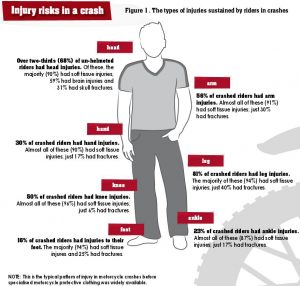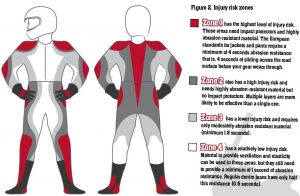Motorcycle Safety Gear Guide
RIDE FOR EVER
GOOD GEAR GUIDE
- Cover your whole body.
- Check the seams on your gear. There should be more than one line of stitching, and at least one line of concealed stitching on exposed seams.
- Check that all fastenings are secure and protected from contact with the road or other surfaces in a crash.
- Avoid external pockets or straps that could become tear points or snag on something in a crash.
- Use insulated, waterproof and windproof materials to protect you from the cold.
- Use reflective or light colours and ventilation to protect you from heat.
- Check that all your gear fits you properly so that it will remain in place in a crash.
- Don’t carry anything in your pockets that could cause injury in a crash.
-
Use impact protectors over your joints.
-
Protect your skin with abrasion-resistant material in vulnerable areas.
How Can The Right Gear Improve Your Ride?
Protection from the cold
Protection from moisture
Waterproof, breathable clothing is the key to keeping comfortably dry. There is a big difference between waterproof and water-resistant clothing. While water cannot penetrate waterproof fabric, it will eventually soak through a water-resistant lining. Good waterproof gear should be breathable. This means that it lets your sweat out, while preventing rain from getting through. PVC or plasticised nylon oversuits are waterproof, and offer useful rain protection in an emergency, but are not breathable. The result will be damp clothes and rapid heat transfer.
Protection from heat
 Ventilation and reflection are the keys to improving riding comfort in hot weather. Good ventilation allows the wind to flow through the clothing and over your skin to evaporate sweat. Well-ventilated gear allows air to enter through vents or mesh panels (in ‘zone 4’ – see Figure 2). Air exit points are at the back. The outer layer should also be designed to reflect rather than absorb heat from the sun and the road surface. Lighter colours reflect heat, while dark colours absorb it. There are a number of new materials on the market that are designed to improve comfort in hot weather. When riding in hot weather, remember to drink lots of water to replace what you lose through sweating.
Ventilation and reflection are the keys to improving riding comfort in hot weather. Good ventilation allows the wind to flow through the clothing and over your skin to evaporate sweat. Well-ventilated gear allows air to enter through vents or mesh panels (in ‘zone 4’ – see Figure 2). Air exit points are at the back. The outer layer should also be designed to reflect rather than absorb heat from the sun and the road surface. Lighter colours reflect heat, while dark colours absorb it. There are a number of new materials on the market that are designed to improve comfort in hot weather. When riding in hot weather, remember to drink lots of water to replace what you lose through sweating.
How Can the right gear reduce your risk of Injury?
No matter what you are wearing, your chance of surviving a direct impact with a solid object reduces as the speed of the impact increases. however, many motorcycle crashes do not involve direct impacts, nor do they occur at high speed. The right gear can prevent or reduce many of the most common rider injuries.
Design and construction
Impact protection
